Planning to see the Sistine Chapel and want to know more about the masterpieces you’ll be looking at? To help you add depth and meaning to your trip, we detail the top things to see in the Sistine Chapel and why they are so important.
Pro Tip: Planning your visit to the Vatican in Rome? Bookmark this post in your browser so you can easily find it when you visit the Sistine Chapel. See our guide to Vatican City for more planning resources, our top Vatican tours for a memorable trip, and how to visit the Vatican.
Top Things To See in the Sistine Chapel
Entering the Sistine Chapel for the first time is an unforgettable moment. When you get a sense of the scale of the paintings, realize how long it took to decorate, and discover the artists involved, it’s awe-inspiring.
Originally named Capella Magna (Great Chapel), it was restored by Pope Sixtus IV (1471 to 1484) in 1480. He had famous early-Renaissance artists (who lived a generation before Michelangelo and Raphael) paint the fake draperies, the side walls depicting the life of Moses and Christ, and Pope Sixtus’ nephew (above the windows).
Pope Julius II had Michelangelo paint the ceiling in 1508 and Clement VII commissioned him again in 1533 to paint the back wall with the Last Judgement. The artists who dedicated years of their lives to the Sistine Chapel were some of Italy’s most celebrated Renaissance artists.
I cannot tell you how much I wished you were here, for until you have seen the Sistine Chapel, you can have no adequate conception of what man is capable of accomplishing.
Johann Wolfgang von Goethe
Not ready to book a tour? See if a Vatican tour is worth it.
17. Central Panels
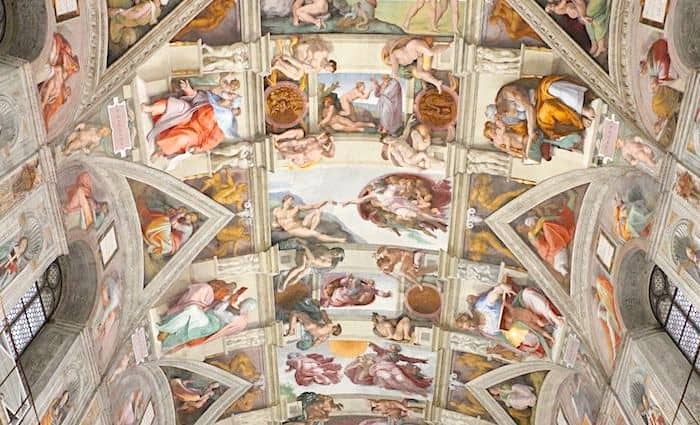
Michelangelo | 1508-1512 | Fresco | Ceiling
Further on, I’ll highlight some individual paintings from the central panels. However, these central paintings are so good that I felt the entire ceiling deserved a dedicated spot. Michelangelo painted the central panels of the Sistine Chapel.
They depict the early stages of the creation of the universe as defined by Jewish, Christian, and Islamic dogma. It’s a shared chapter of the sacred book of Genesis, which details the creation of all things—again, according to dogma. It’s arguably the most influential chapter of any book in Western Civilization.
Today, many rely on science to solve the mystery of the world’s creation. When Michelangelo painted the ceiling of the Sistine Chapel in the 16th century, however, there were very few that looked to science for answers.
Art as Visual Translation
Most people couldn’t read, so art was the ideal way to explain the story of the bible. Although the Sistine Chapel wouldn’t become a public venue in his lifetime, artists almost always took this into consideration. Art, in its purest form, was about translating written text into a visual form that the illiterate could understand.
Michelangelo was commissioned to paint the Sistine Chapel by Pope Sixtus. His job was to depict how we arrived on Earth and our purpose on the ceiling of the most important of all chapels.
And the outcome truly shows how seriously he took this commission. A religious person would say it was God who painted through Michelangelo, considering he hit a grand slam on his first-ever fresco. Yes, the ceiling of the Sistine Chapel was Michelangelo’s first fresco.
The Central Panels
The ceiling is broken down into Central Panels, Sibyls and Prophets, Christ’s forefathers, and four corner stories. The heart of the ceiling is the nine central panels with arguably the most recognizable painting in the world—the Creation of Man panel. These central panels are:
- Separation of Light from Darkness
- Creation of the sun, moon, and planets
- Separation of Land from Sea
- Creation of Man
- Creation of Eve from the Body of Adam
- Banishment from the Garden of Eden
- The Sacrifice of Noah
- The Flood
- The Drunkenness of Noah
16. Legacy and Death of Moses
Luca Signorelli | 1481 – 1483 | Fresco | Lateral Wall: Life of Moses
This painting depicts the final episodes in the life of Moses. There’s controversy about whether Signorelli really painted it or not. Giorgio Vasari, the leading biographer of the day, was convinced he did. However, many art historians today believe it was actually Bartolomeo Della Gatta.
On the right-hand side, there is Moses reading to his followers. At his feet is the ark of the covenant where the tablets of the law are kept. The scene in the middle shows Moses conferring power onto Joshua, who will take over God’s flock.
In the background, Moses is speaking with an angel who is showing him the promised land, which he doesn’t get to see before he dies. Then in the left corner, you’ll see his followers lamenting his death.
Popular Vatican Tours

Best Selling Tour
Privileged Entrance Vatican Tour with Sistine Chapel
This our most popular and longest-running Vatican tour to date. It enters the Vatican City & Museums an hour before the public opening and visits the Sistine Chapel as it opens. Admissions are included and our English-speaking guides do a wonderful job bringing the museums to life! Admissions included.





(254)
See Prices
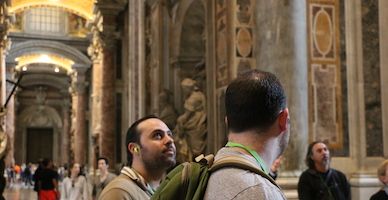
Best Price!
Skip the Line Vatican Tour with Sistine Chapel & St. Peter’s Basilica
One of our most popular Vatican tours since it is such an amazing value. Skip the line to get inside with a super-knowledgeable English-speaking guide that will bring the museum to life. Stories of the artists, popes, conspiracy, love, and of course tragedy! Admissions included.





(240)
See Prices
Not ready to book a tour? Check out our best Vatican tours to take and why.
15. Creation of Eve from the Body of Adam
Michelangelo | 1508 – 1512 | Fresco | Ceiling
In the book of Genesis, the following is written about the creation of Eve: “So the Lord God caused a deep sleep to fall upon the man, and he slept; then he took one of his ribs and closed up its place with flesh. And the rib that the Lord God had taken from the man he made into a woman and brought her to the man.”
Here, you see Eve springing to life from what looks like a sleeping Adam as God beckons her to him.
14. The Sacrifice of Noah
Michelangelo | 1508 – 1512 | Fresco | Ceiling
In the bible it says: “Noah built an altar to the Lord; he took one of each kind of ritually clean animal and bird and burned them whole as a sacrifice on the altar.The odor of the sacrifice pleased the Lord.”
In biblical chronology, this actually happens after the flood, but it is probable that Michelangelo wanted more space for the Flood, since that painting was to be such an epic scene, so this was placed before. The story tells of sacrifice to God after surviving the Flood, as mentioned above.
13. The Flood
Michelangelo | 1508 – 1512 | Fresco | Ceiling
In the bible, it reads: “Now the flood was on the earth forty days. The waters increased and lifted up the ark, and it rose high above the earth.”
Supposedly, Michelangelo created this painting out of chronological order (in the bible), so that he would have more room for this painting. There’s a lot going on here, so spend a little while looking up at this painting.
God decided to create a flood for 40 days and nights to destroy all the evil in the world. He commanded Noah to build an ark of gopher wood and collect a pair of all the animals.
Michelangelo depicts this epic event not only of the ark but also of various failed attempts by others to survive, by climbing up a hill or scrambling onto a boat. In the end, they all perish except for those in Noah’s ark.
You will notice a gap on one side of the fresco. It happened in 1797 when an explosion of some barrels of gunpowder stored at the top of the nearby Castel Sant’Angelo caused this portion of the ceiling to fall.
Enrico Bruschini, Art Historian and Official Vatican Tour Guide
12. The Last Supper
Cosimo Rosselli | 1481 – 1483 | Fresco | Lateral Wall: Life of Jesus
Many people think there’s only one painting of the Last Supper—the one by Da Vinci. On the contrary, the Last Supper was quite a popular theme for paintings and hundreds of them exist. Each last supper painting has its own particular characteristics and this one by Cosimo Rosselli is no different.
In the painting, Jesus has just shared the news that he’s going to die after passing around the bread and some wine. The Apostles’ faces don’t have expressions of surprise, despite the news. This is because, in the Renaissance, the focus was on ideal beauty rather than the actual event taking place. The only Apostle on the other side of the table is Judas, who is already holding a sack of silver coins for his betrayal to tell the Jewish elders who Jesus was.
Above everyone, there are three windows, which allude to the three events from the bible that will take place next. From the left, first there’s the prayer on the mount of olives, followed by the betrayal, and finally the crucifixion.
Interesting Fact
Cosimo Rosselli’s last name derives from the word meaning red, and there’s a man in the right-hand corner looking right at us with a red hat on!
11. David and Goliath
Michelangelo | 1508 – 1512 | Fresco | Ceiling: Corner Painting
One of the more famous stories in the bible is the story of David and Goliath—a true story of an underdog. It makes me think of the film “Rudy.” Goliath, the giant, is struck down by David who is much smaller in stature but greater in heart.
Michelangelo is showing us the moment when David is about to strike the giant and behead him. David is straddling him with his sword high in the air, and the terrified Goliath accepts his fate.
Popular Tours from Rome
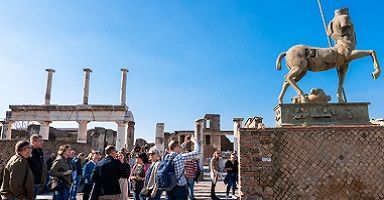
Best Seller
Unforgettable Rome Day Trip to Pompeii and Sorrento
This is the best way to see Pompeii and the Amalfi Coast from Rome. You’ll take private transportation with our guide down to Pompeii where an archeologist will tour our small group through the ruins. Then we’ll head over to Sorrento which is the tip of the Amalfi Coast before returning to Rome. Tickets, transportation, and guides are included in the price.





(77)
See prices and more info
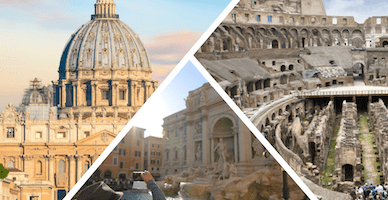
Best Seller
Rome in a Day Tour with Vatican, Sistine Chapel, Colosseum, and More!
Looking to get much of your sightseeing done in one day? This tour enters the Vatican an hour before opening and visits the Colosseum along with other sites like the Pantheon, Spanish Steps, and Trevi Fountain. All admissions and transportation are included as well as a licensed English-speaking guide!





(386)
See prices and more info
Not ready to book a tour? Find out if Rome tours are worth it.
10. The Journey of Moses in Egypt
Pietro Perugino | 1481 – 1483 | Fresco | Lateral Wall: Life of Moses
As in most of these side panels, there are multiple scenes in this painting. Moses spends 40 years in the land of Midian after killing an Egyptian. After these 40 long years, God gives Moses a sign to come back to Egypt to save his people from the excesses and tyranny of the Pharaoh.
The next scene shows a story from the book of Exodus where God has threatened Moses. At that point, Mose’s wife, Zipporah, rushes to sacrifice an animal in order to save Moses from death.
On the lower right-hand side of the painting, Moses’ baby son, Eliezer, is in the process of being circumcised by his mother Zipporah who is a Midianite. In the center of the painting, Moses is stopped by an angel, which was usually a sign of God.
9. Events in the Life of Moses
Sandro Botticelli | 1481 – 1483 | Fresco | Lateral Wall: Life of Moses
When you ask someone to name a painting by Botticelli, they always say The Birth of Venus. And rightly so, it’s an amazing painting. However, most don’t know that he painted in the Sistine Chapel. If you look closely at this painting and the Temptation of Christ (see below), you’ll instantly recognize the faces of his characters.
This fresco shows various episodes about Moses’ youth from the book of Exodus. There are three scenes, and the story goes from right to left. The first scene is when Moses kills a man for insulting an Israelite and then flees into the desert in Midian.
The next scene is when he fights off a group of shepherds who prevented the daughters of Jethro from watering their flock at the well. One of those daughters was Zipporah who would eventually become Moses’ wife. You’ll notice in this scene the beautiful woman with blond hair—a staple in Botticelli’s paintings.
The final scene starts on the top left side of the painting where Moses hears the voice of God and removes his sandals. He approaches the burning bush where the voice of God tells him to return to Egypt and announce to everyone that he will be freeing the Jews from Slavery.
8. Baptism of Christ
Pietro Perugino | 1481 – 1483 | Fresco | Lateral Wall: Life of Jesus
The Baptism of Christ shows the real beginning of Jesus’ journey to become the messiah. On the right-hand side, you see John the Baptist speaking with a crowd. In the back left, you can see Jesus preaching to a different crowd.
The main attention is focused on the center of the painting. Here, John the Baptist is starting to pour water over the head of a pious Jesus. There are crowds on both sides of the painting watching the event and, interestingly, they are all dressed in period Renaissance-style clothes. Above, you see God watching over the entire proceedings.
In the background, there are other scantily clad men who, it would seem, are waiting to be baptized after Jesus. Perugino’s mastery of perspective is also on display here as the painting reveals a castle in the background. Then goes even farther back to show distant mountains and what looks like a lake. Raphael, who was Perugino’s student, was very fond of using this kind of background.
7. Banishment from the Garden of Eden
Michelangelo | 1508 – 1512 | Fresco | Ceiling
Imagine what it would feel like to be in the Garden of Eden? Now imagine you get kicked out of it. How would you feel? Looking at this painting will give you an idea. Michelangelo shows two scenes here with the first scene on the left side interpreting original sin. In this scene, they are young, healthy, and beautiful.
They are still perfect beings without any sense of shame or wrongdoing. The serpent is in the tree and suggests to Eve that they eat the forbidden fruit. Eve tells Adam to eat it, and in doing so they have disobeyed God.
The scene on the right shows what happens next. First of all, they become aware of their nudity and of the fact that they are humans. They are therefore banished from the Garden of Eden, and the contrast in their figures from those on the left is astounding.
They have horror in their eyes. The expression on their faces shows exactly how anyone banished from paradise would feel. In this painting, Michelangelo would have been heavily influenced by the artist Masaccio whose painting he would have seen in the Brancacci chapel in Florence.
6. Judith and Holofernes
Michelangelo | 1508 – 1512 | Fresco | Ceiling Corner Painting
Judith and Holofernes is a painting that you’ll need to get right under to see really well. Once you’ve had a good look at it, you’ll almost cringe away from it it’s so graphic. The expression “head on a platter” originates here.
According to the bible, the city of Bethulia was being besieged by the Babylonian king Nabucodonosor. To save her city, Judith came to his tent in the night, and when he was overcome with wine, she cut off his head.
She then put his head on a plate and showed it to his soldiers, saving her city. Michelangelo breaks this up into three scenes: the sleeping guards, the head on a plate, and the beheaded King.
If you look closely at the head on the platter you can see that which almost all consider to be a magnificent self-portrait of Michelangelo. The face is very similar to that sculpted by Daniele da Volterra and preserved in Florence in the Casa Buonarroti.
Enrico Bruschini, Art Historian and Official Vatican Tour Guide
5. Passage of the Red Sea
Biagio d’Antonio / Cosimo Rosselli | 1481 – 1483 | Fresco | Lateral Wall: Life of Moses
It is not certain whether the painter of this was Cosimo Rosselli or his assistant Biagio d’Antonio, so we’ll give them both credit. This epic story in the Bible, which is also one of the most famous in the Old Testament, shows how Moses escapes with all his followers, and they come to the Red Sea.
The Egyptian warriors are close on their heels, and it looks like a dead end. But Moses prays to God who parts the waters of the Red Sea, allowing Moses and his followers to walk through the sea on dry land. The Pharaoh’s army proceeds as well, but after the last of Moses’ followers make their way through, the waters come crashing down and destroy the entire army.
Popular Vatican Tours

Best Selling Tour
Privileged Entrance Vatican Tour with Sistine Chapel
This our most popular and longest-running Vatican tour to date. It enters the Vatican City & Museums an hour before the public opening and visits the Sistine Chapel as it opens. Admissions are included and our English-speaking guides do a wonderful job bringing the museums to life! Admissions included.





(254)
See Prices

Best Price!
Skip the Line Vatican Tour with Sistine Chapel & St. Peter’s Basilica
One of our most popular Vatican tours since it is such an amazing value. Skip the line to get inside with a super-knowledgeable English-speaking guide that will bring the museum to life. Stories of the artists, popes, conspiracy, love, and of course tragedy! Admissions included.





(240)
See Prices
Not ready to book a tour? Check out our best Vatican tours to take and why.
4. Temptations of Christ
Sandro Botticelli | 1481 – 1483 | Fresco | Lateral Wall: Life of Jesus
The devil tempted Jesus many times to try and break him from his attempt to become the Messiah. In the upper left corner, Satan is disguised as a hermit and asks Jesus for a miracle to test him. In the center background, Satan tries to get Jesus to jump off the temple.
The temple resembles the construction of the Santo Spirito church by the Vatican, which Sixtus IV was building. The last scene is on the right-hand side where Jesus throws Satan off a cliff.
In the center of the painting, there is a sacrificial rite taking place. This interpretation usually refers to the leper who, after he was healed by Jesus, made a sacrifice in his honor.
Some art historians see this scene as allegorical with the older priest being Moses and the young man being Jesus. The sacrifice is that of Jesus himself making the ultimate sacrifice for mankind.
3. Handing Over the Keys
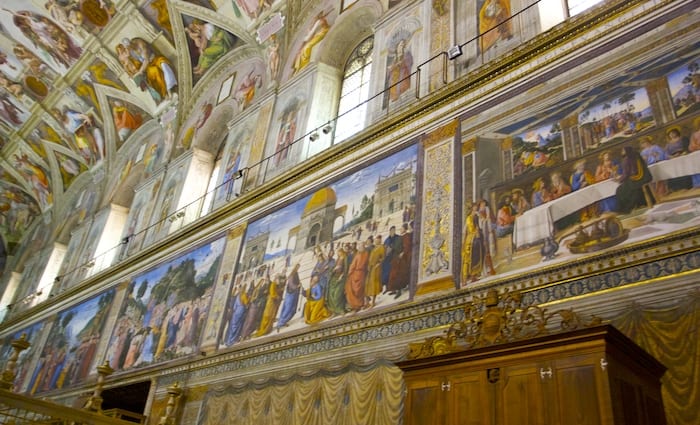
Pietro Perugino | 1481 – 1483 | Fresco | Lateral Wall: Life of Jesus
I’m going to go out on a limb here and say that this is the third most famous painting in the chapel after the ceiling and Last Judgement. Perugino is able to create extreme depth in the painting through his expert use of perspective. In doing so, he created three layers of composition.
In the foreground and the most important scene is Christ standing in front of a kneeling St. Peter. On both sides of them, there’s the usual group of people, as in the other paintings, looking on at the event with almost disinterest but in line with the standards of the time. Peter is receiving the two keys (the gold key is that of heaven and the silver is that of the earth) from Jesus.
Behind them, there’s a massive piazza, which is not based on any real place, but more of an ideal piazza. From a distance, it actually looks like people are ice skating, but they are actually getting ready to stone a future martyr.
In the background, there are two arches, which are replicas of the Arch of Constantine. Constantine again plays an important role in Christianity since he is accredited as being the first Christian Emperor. Finally, in the background, you can see hills off in the great distance, exemplifying Perugino’s use of perspective.
2. The Last Judgement
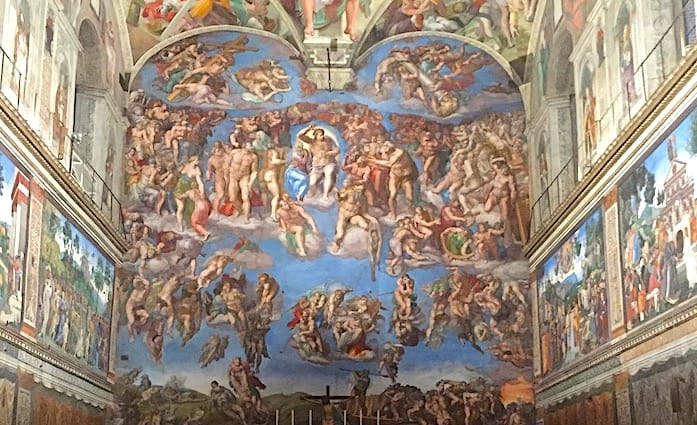
Michelangelo | 1536 – 1541 | Fresco | Sistine Chapel
This fresco was one of the last additions to the Sistine Chapel (finished in 1541) and was painted by none other than Michelangelo himself. By the time this painting was finished, he had spent almost 10 years of his life in the Sistine Chapel painting the ceiling and back wall.
The entire art piece is a whopping 42 feet (13 meters) high and 39 feet (12 meters) wide. It took Michelangelo five years to paint. Picture any 61-year-old man you know and imagine them painting a huge wall for five years. On top of that, they would need to be able to produce a painting that would be described as one of the best ever created in the history of man. Now you understand why Michelangelo is arguably the greatest of all time.
The Top
In the upper lunettes, angels are carrying instruments used during the Passion of Christ (the cross, the whip, the column he was whipped on, and the crown of thorns). Below, an extremely muscular Jesus with no beard in a powerful position is presiding over the entire scene with a radiant halo bursting behind him.
Recognizable figures include John the Baptist, the Virgin Mary, St. Peter holding the keys, and various other saints holding the instrument they were martyred with in their hands.
The Middle
Below, a group of angels is blowing trumpets and holding two books that decide their fate to either ascend to heaven or go to hell. Those redeemed are ascending from their graves, while the condemned are descending into the underworld.
Here, you can see a group of angels blowing trumpets and holding two books. The larger of the two contains the names of those damned and going down to Hell, The smaller book has the names of the redeemed who will ascend to Heaven. On the left-hand side, as the redeemed rise from their graves, there are even fights breaking out with demons trying to hold onto the ascending bodies. The angels, however, push them back to the Underworld.
The Bottom
Here, Michelangelo alludes to Greek mythology with the demon (Charon) on a boat bringing all the damned souls over to the Underworld. On the far right side, you will see the Devil himself and all the damned and lost souls behind him in Hell.
Upon ascending to the throne of St. Peter, Pope Paul III (Pontiff 1534 – 1549) was leading a church in a time of great crisis. The major sack of Rome (1527) had been just seven years earlier and was still fresh in the minds of many. He was also facing increasing external pressure as Protestantism was in its infancy. What better way to fight back the critics and take control of the church than with a painting about our ultimate salvation?
Interesting Facts
When the painting was unveiled, many were shocked by the amount of nudity in the painting. Cardinal Biagio da Cesena said that this was better suited for a tavern than the holy chapel of the Pope. It is said that Michelangelo then changed the face of the devil to that of the Cardinal and wrapped a snake around his body biting him in the groin area.
Below Jesus, you’ll find St. Bartholomew who was skinned alive. In his right hand, he is holding a knife and in his left hand his own skin! Many contemporaries suggested that Michelangelo did a self-portrait in the skin!
If people knew how hard I worked to get my mastery, it wouldn’t seem so wonderful at all.
Michelangelo
1. The Creation of Man
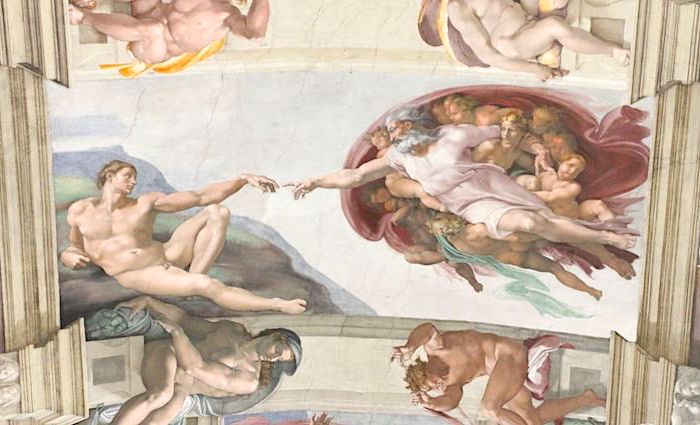
Michelangelo | 1508-1512 | Fresco | Ceiling
One of the most famous and reproduced paintings on the planet (and the top thing to see in the Sistine Chapel) is Michelangelo’s Creation of Man. God is breathing life into Adam who is in a reclining position and embodies perfection as described in the Old Testament of a man being an imitation of God himself.
A magical enigma, here, is that the hands between the two almost touch, but don’t. Many art historians point to this painting as having significant allegorical connotations between Michelangelo and his father.
Their relationship had always been very rocky due to the fact that his father never truly approved of his profession. In not allowing their hands to touch, he shows his father’s dissatisfaction with him.
Not ready to book a tour? Find out if a Vatican tour is worth it.
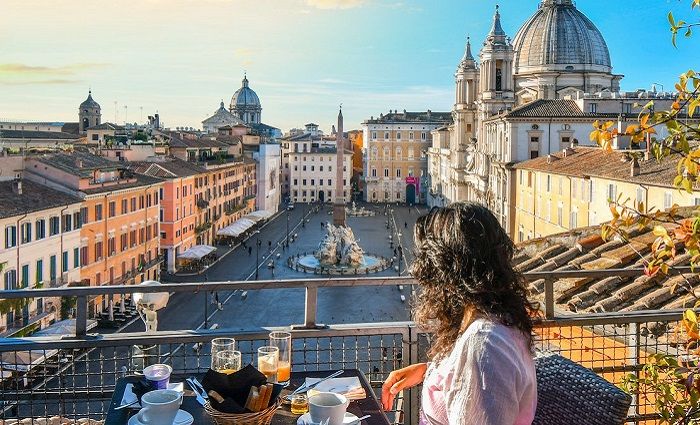
Where To Stay in Rome
Rome has a rich cultural history and many iconic landmarks to explore. Plan where to stay in the magnificent Eternal City in the best neighborhoods.

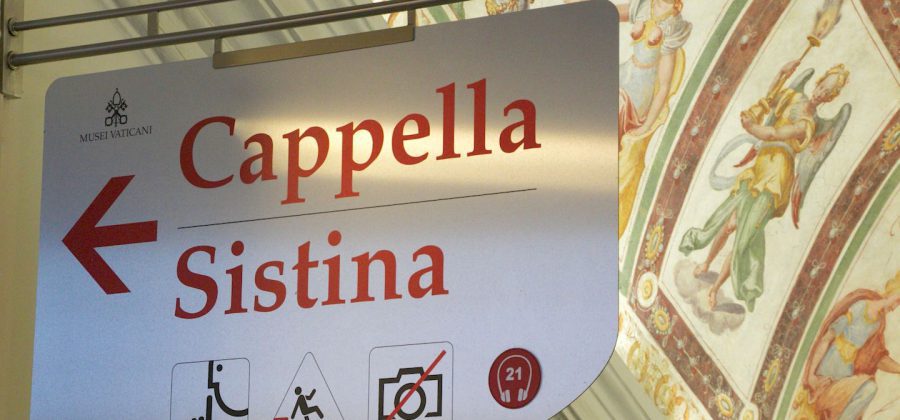
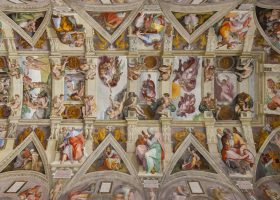
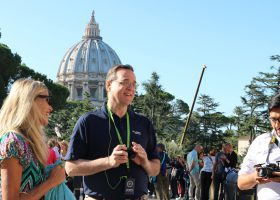
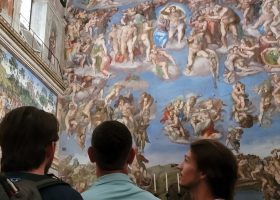
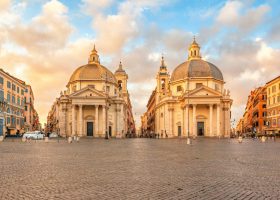
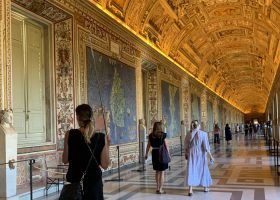
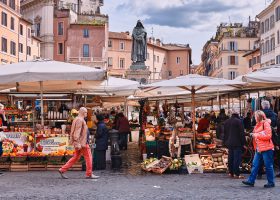
Leave a Comment